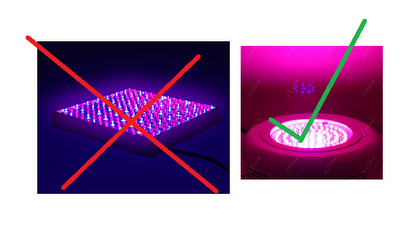Here is when LEDS come to save the day. Light emitting diodes are very efficient in generating light from electricity (wasting only a small fraction of the energy as heat) and they also provide light in very narrow ranges which can be tuned to only supply the wavelengths needed by plants. The reason why plants are green is because their main photosensitive pigment is chlorophyll (there are several types by the way), a pigment that absorbs red and blue wavelengths and reflects green. With this in mind – not only are LEDS able to supply your hydroponic plants witha higher efficiency – but they are also able to provide your plant with only the colors of light it needs. Achieving a double gain in efficiency. As a matter of fact, a LED lamp with just 60W is enough to grow a tomato plant.
However, not all LEDS are created equal. Many people think that all LED lamps are the same and they end up buying cheap LED lamps or panels that simply do not provide plants with the energy they need to grow. There are generally two kinds of LEDS available for lamps. The first kind – low power LEDS – are the type of lights used to make your computer and keyboard lights. These lights are weak and they are usually sold in the forms of panels with HUNDREDS to make them appear “useful” for hydroponic growth. The second – high power LEDS – are lights used for traffic lights and high power applications and they ARE the type you need for hydroponic growth.
– –
–
In general, when you are looking to replace your TMH or HPS lamps with LEDs you need to look for high power LED lamps in the range of 50-100W for each 400W lamp you want to replace. You also need to look at the red to blue light ratio since different plant varieties need different proportions of light. If you are growing plants that need to have flowers then you will need to aim for a red to blue ratio of about 8:2 while plants that do not produce flowers may grow well with only red lights. This is – of course – a very course guide to the light color ratio but it may guide you well when you are looking for lamps for a certain crop.
With this small guide and knowledge you will be able to eliminate most lamps that do not work and buy high power LED lamps that will deliver and provide you with a much more efficient, cooler and more eco-friendly way to provide your hydroponic crop with artificial light.




